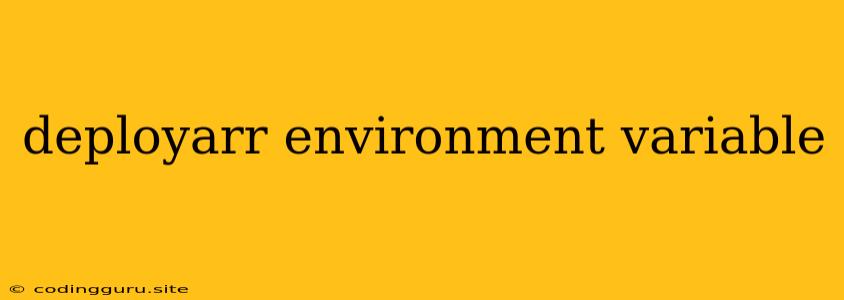Understanding and Using Environment Variables with Deployarr
Deployarr, a powerful and versatile tool for automating software installation and management, leverages environment variables to enhance its functionality and provide flexibility. Environment variables act as dynamic placeholders, allowing you to configure and customize Deployarr's behavior without directly modifying its core code. This article will explore the key aspects of utilizing environment variables within your Deployarr setup.
Why Use Environment Variables?
-
Security: Storing sensitive information like API keys, passwords, and database credentials directly within the Deployarr configuration file is a security risk. Environment variables allow you to keep these credentials separate and out of version control systems, preventing accidental exposure.
-
Flexibility: Environment variables enable you to tailor Deployarr's configuration to different environments, such as development, testing, and production. You can easily switch between configurations without modifying Deployarr's codebase.
-
Organization: Environment variables help organize your settings, making it easier to understand and manage different configuration parameters.
Common Deployarr Environment Variables
Deployarr provides a range of environment variables to customize various aspects of its behavior:
-
DEPLOYARR_URL: Specifies the base URL of your Deployarr instance. -
DEPLOYARR_API_KEY: Used for authentication with the Deployarr API. -
DEPLOYARR_DATABASE_URL: Defines the connection details for your Deployarr database. -
DEPLOYARR_EMAIL_HOST: Sets the hostname for your email server. -
DEPLOYARR_EMAIL_PORT: Sets the port number for your email server. -
DEPLOYARR_EMAIL_USERNAME: Sets the username for your email server. -
DEPLOYARR_EMAIL_PASSWORD: Sets the password for your email server. -
DEPLOYARR_SMTP_TLS: Enables or disables TLS encryption for email. -
DEPLOYARR_DEBUG: Enables debug logging for troubleshooting.
Setting Environment Variables
Depending on your operating system and environment, there are several ways to set environment variables:
- Linux/macOS Terminal:
export DEPLOYARR_URL="https://your-deployarr-instance.com"
export DEPLOYARR_API_KEY="your-api-key"
- Windows Command Prompt:
set DEPLOYARR_URL=https://your-deployarr-instance.com
set DEPLOYARR_API_KEY=your-api-key
- Docker:
ENV DEPLOYARR_URL=https://your-deployarr-instance.com
ENV DEPLOYARR_API_KEY=your-api-key
- Environment Files (e.g., .env):
DEPLOYARR_URL=https://your-deployarr-instance.com
DEPLOYARR_API_KEY=your-api-key
Note: Use a .env file only if you have a trusted environment and are not sharing the file with others.
Best Practices for Using Environment Variables
-
Store Credentials Securely: Always use environment variables to store sensitive information like API keys, passwords, and database credentials.
-
Use a Separate Environment File: Store environment variables in a separate file (like
.env) to keep your project's code clean and organized. -
Use a Password Management Tool: Employ a password manager to store and manage sensitive credentials safely.
-
Restrict Access: Limit access to environment files and variables to authorized personnel.
-
Use a Configuration Management Tool: Implement a configuration management tool like Ansible or Puppet to manage environment variables and configurations across multiple systems.
Example: Configuring Email Settings
Let's say you want to configure Deployarr to send email notifications using a custom SMTP server. You would use the following environment variables:
export DEPLOYARR_EMAIL_HOST="smtp.example.com"
export DEPLOYARR_EMAIL_PORT="587"
export DEPLOYARR_EMAIL_USERNAME="[email protected]"
export DEPLOYARR_EMAIL_PASSWORD="your-email-password"
export DEPLOYARR_SMTP_TLS="true"
Conclusion
Environment variables are a powerful tool for customizing Deployarr's functionality and ensuring secure storage of sensitive information. By implementing best practices and using a consistent approach, you can effectively utilize environment variables to enhance your Deployarr experience and streamline your software management workflow.
